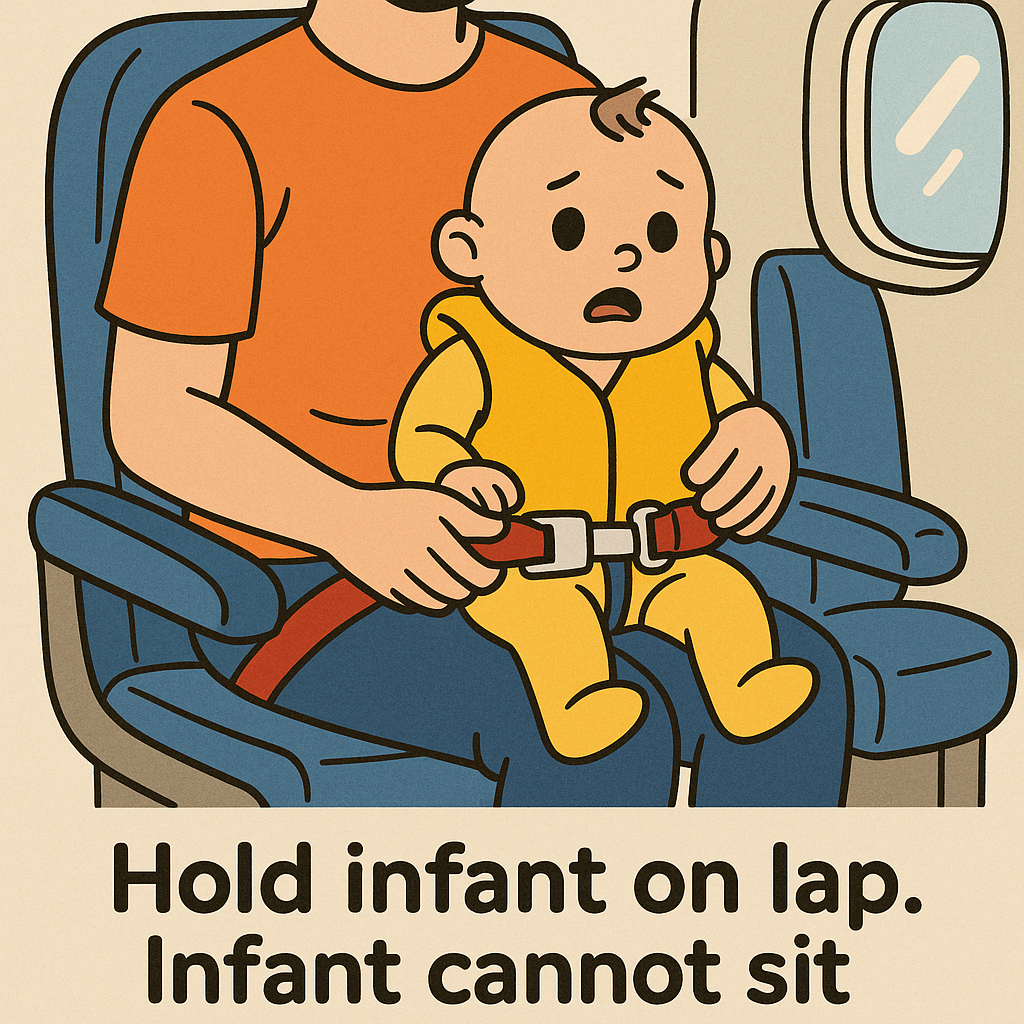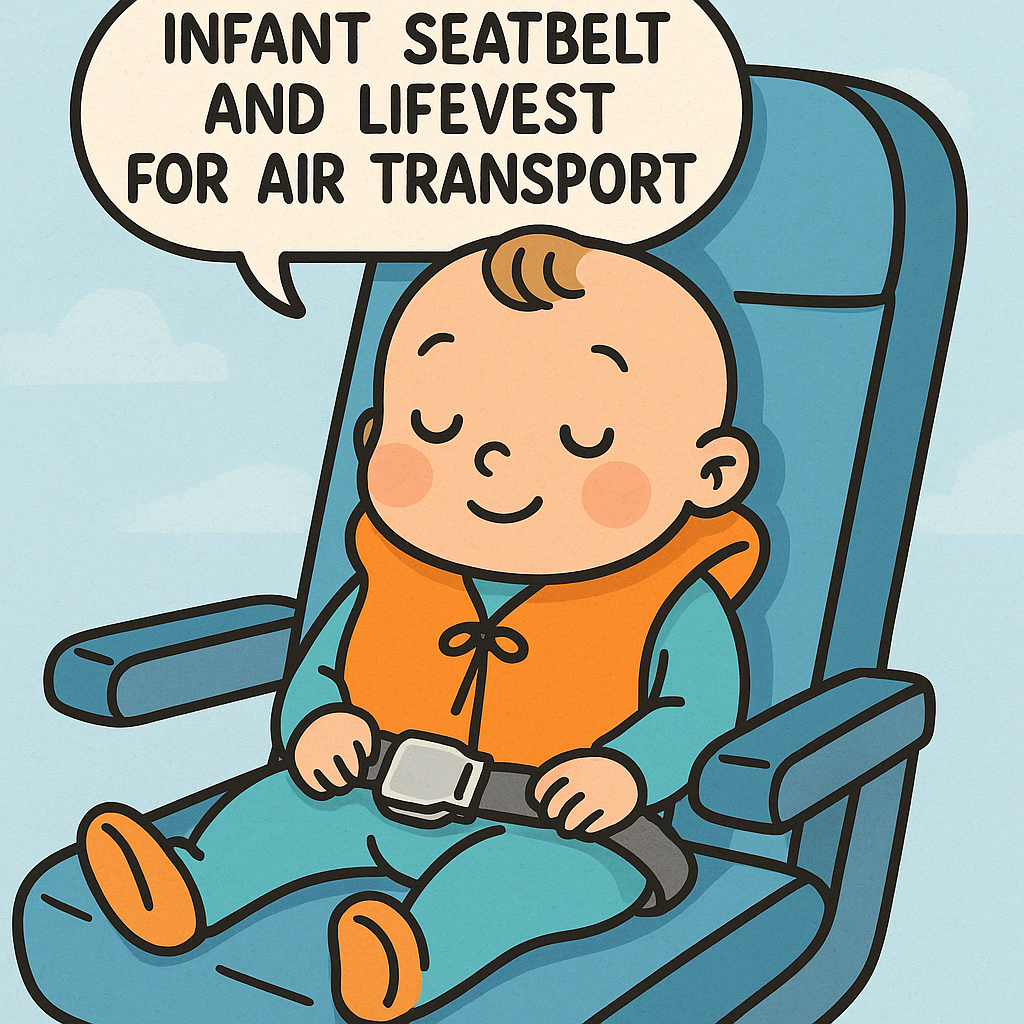ทารกและเด็กเล็กบนเครื่องบินมักถูกจัดเป็น “ผู้โดยสารที่ต้องการการคุ้มครองพิเศษ” เพราะขนาดร่างกายและการตอบสนองต่อแรงเฉื่อยต่างจากผู้ใหญ่ ทำให้วิธีการยึดตรึง (restraint) และอุปกรณ์ลอยน้ำต้องออกแบบเฉพาะสำหรับเด็กเพื่อให้ศีรษะหงาย น้ำจะไม่อุดทางเดินหายใจ และเพื่อให้สามารถช่วยเหลือลงน้ำได้อย่างปลอดภัยในกรณีเหตุฉุกเฉินทางทะเล.
Infant restraints (lap belts, child restraint systems—CRS, and aviation harnesses like CARES) and infant lifejackets are specialized because infants have different body proportions, lower muscle tone, and proportionally larger heads. These factors increase the risk of airway compromise and neck/head injuries during sudden deceleration or turbulence unless the child is properly restrained; infant flotation devices are shaped to support the head and maintain a face-up position in the water. หน่วยงานการบินแห่งสหรัฐอเมริกา+1
ที่มาของความเสี่ยงเชิงชีวกลศาสตร์ (biomechanics) คือแรงเฉื่อย (inertial forces) ที่เกิดขึ้นเมื่อเครื่องบินหยุดกะทันหันหรือเกิด turbulence — แม่หรือผู้ดูแลไม่สามารถยึดทารกด้วยแขนได้อย่างเพียงพอเมื่อเทียบกับอุปกรณ์นิรภัยที่ยึดติดกับที่นั่ง ผลคือทารกมีความเสี่ยงต่อการกระทบศีรษะ บาดเจ็บคอ หรือการเลื่อนลงใต้เข็มขัด (submarining) ในการลงจอดฉุกเฉินหรือการชนเล็กน้อย.
Several regulatory and safety reviews emphasize that an adult’s arms are not a reliable restraint during unexpected events; the FAA and other authorities therefore recommend/endorse using approved child restraint systems (CRS) or approved aviation harnesses, and note that unrestrained lap children are prone to in-flight injuries, especially during turbulence and meal service. หน่วยงานการบินแห่งสหรัฐอเมริกา+1
“Infant seatbelt” อาจหมายถึง (1) เข็มขัดนิรภัยเสริมสำหรับทารกที่สายการบินออกแบบ, (2) extension/loop ที่ใช้ให้เข็มขัดผู้ใหญ่ครอบได้พอดี, (3) CRS (car-seat ที่มีฉลากที่อนุญาตใช้บนอากาศยาน) หรือ (4) harness แบบพกพาเฉพาะการบิน เช่น CARES — แต่ละแบบมีเงื่อนไขรับรองและช่วงน้ำหนัก/อายุที่แตกต่างกัน.
Terminology clarification: “infant seatbelt” can refer to airline-provided lap belts for infants, belt extensions, certified child restraint systems (CRS) that are FAA/NHTSA accepted for aircraft use, or aviation-specific harnesses such as the CARES harness. Each device has certification, labeling, and weight/age limits that determine whether it is approved for aircraft use. หน่วยงานการบินแห่งสหรัฐอเมริกา+1
CRS (child restraint systems) สำหรับเครื่องบินต้องมีฉลากการรับรอง (เช่น FMVSS/NHTSA label หรือ FAA approval) หรืออยู่ในรายชื่อที่ FAA ระบุ และมีคู่มือการติดตั้งบนที่นั่งอากาศยาน ส่วน CARES harness เป็นอุปกรณ์ที่ได้รับการออกแบบเฉพาะการบินสำหรับเด็กน้ำหนักประมาณ 22–44 lb (≈10–20 kg) ที่นั่งเอง — เหมาะสำหรับเด็กที่โตพอจะนั่งบนที่นั่งของตนเอง แต่เข็มขัดมาตรฐานยังหลวมเกินไป.
Federal guidance and advisory circulars explain that child/infant restraint systems with appropriate certification (FMVSS/NHTSA or FAA) are approved for use in aircraft and that devices like the CARES harness augment the airplane seat belt for children between ~22–44 lb (10–20 kg). CARES is widely accepted by many carriers because it is FAA-approved for aviation use. หน่วยงานการบินแห่งสหรัฐอเมริกา+1
เสื้อชูชีพสำหรับทารก (infant lifevest) แตกต่างจาก lifevest สำหรับผู้ใหญ่ในหลายจุด: มีขนาดและปริมาตรลอยน้ำ (buoyancy) ที่เหมาะกับน้ำหนักทารก มีช่องรองศีรษะ/คอเพื่อช่วยให้ศีรษะอยู่ในท่าหงาย รวมทั้งรูปแบบสายรัดที่ลดโอกาสที่ทารกจะหลุดออกจากอุปกรณ์เมื่ออยู่ในน้ำ.

Infant lifejackets are designed with higher relative buoyancy for small body mass, underarm or twin-cell configurations, and head-support features so that an infant’s airway remains clear and the head remains face-up. Aviation and maritime standards (e.g., CAA specifications and manufacturer technical data) codify these design requirements. หน่วยงานการบินพลเรือนแห่งสหราชอาณาจักร+1
ข้อจำกัดทางกฎหมายและปฏิบัติการ: กฎหลายฉบับระบุว่าต้องมีอุปกรณ์ลอยน้ำสำหรับ ทุกคนบนเครื่อง รวมถึงเด็กที่นั่งบนตัก (in-lap children) — แต่รูปแบบการแจก/จัดเก็บและจำนวน infant lifevest อาจขึ้นกับชนิดเครื่องบินและว่าเที่ยวบินนั้นเป็น “overwater/ditch-certified” หรือไม่ ดังนั้นจึงไม่ใช่ว่าแต่ละที่นั่งจะมี lifevest ขนาดทารกเสมอไป; บางสายการบินเก็บไว้เป็นชุดสำรองหรือแจกเฉพาะเมื่อจำเป็น.
Regulatory guidance (FAA/AC and industry best practices) notes that flotation means must be available for cabin occupants, including lap infants, but operator implementation varies by aircraft certification (e.g., ditching certification), route (overwater flights), and aircraft type — so infant lifevest availability and distribution policies differ between operators. หน่วยงานการบินแห่งสหรัฐอเมริกา+2หน่วยงานการบินแห่งสหรัฐอเมริกา+2
อุปกรณ์แต่ละชนิดมีข้อจำกัดชัดเจนเป็นตัวเลข เช่น CARES สำหรับเด็ก 22–44 lb (10–20 kg), บางรุ่นของ infant lifevest ออกแบบสำหรับเด็กน้ำหนักไม่เกินประมาณ 35 lb (~16 kg) — หากเด็กหนักหรือตัวใหญ่กว่าขอบเขตเหล่านี้ อุปกรณ์จะไม่ให้การปกป้องตามที่ออกแบบไว้ และไม่ควรใช้แทนกัน (adult lifevest ไม่สามารถใช้กับทารกได้ และ infant lifevest ออกแบบให้เด็กไม่สามารถใช้แทนผู้ใหญ่ได้เช่นกัน).
Specific numerical limits matter: CARES is indicated for ~22–44 lb; typical aviation infant lifevest models are rated up to ~35 lb. Using a device outside its rated weight/size compromises buoyancy and fit; moreover, adult lifejackets are inappropriate for infants and vice versa because of neck aperture, buoyancy distribution, and lifting/lowering characteristics. AmSafe+1
คำแนะนำเชิงปฏิบัติสำหรับนักเดินทาง (1) หากเป็นไปได้ จองที่นั่งสำหรับทารกและใช้ CRS ที่ได้รับการรับรองบนเครื่องบิน — นี่คือวิธีที่ปลอดภัยที่สุดระหว่างการเกิดเหตุฉุกเฉินหรือ turbulence.
Practical travel guidance: purchase a separate seat for your infant and use an FAA/NHTSA/Europe-approved CRS installed per manufacturer instructions whenever feasible — this provides the best protection during takeoff/landing and unexpected turbulence. หน่วยงานการบินแห่งสหรัฐอเมริกา+1
คำแนะนำเชิงปฏิบัติ (2) ถ้าเด็กอยู่ในช่วงน้ำหนักที่ CARES ยอมรับ (≈10–20 kg) และคุณต้องการพกอุปกรณ์พกพา CARES อาจเป็นทางเลือกที่สะดวก แต่ต้องตรวจสอบว่า สายการบินยอมรับรุ่น CARES ก่อนการเดินทาง.
If your child’s weight falls in the CARES range (~22–44 lb) and you prefer a portable aviation harness, CARES is a practical option — but always confirm the operating carrier accepts CARES (or the specific harness model) prior to travel and follow installation instructions precisely. AmSafe
ข้อควรระวังเรื่อง lifevest ในการบิน: ห้ามเป่าหรือพอง lifevest ก่อนลงน้ำ — การพองในห้องโดยสารอาจขัดขวางการช่วยเหลือและทำให้การอพยพยากขึ้น เคล็ดลับคือปฏิบัติตามคำสั่งลูกเรือ และใส่ lifevest ให้แน่นและจัดสายรัดให้อยู่ตำแหน่งที่เหมาะสมสำหรับศีรษะและคางของทารก.
Lifevest precautions: do not inflate an infant lifejacket within the cabin; follow crew instructions during a ditching scenario, secure the neck/head support correctly, and ensure the attendant is prepared to assist the infant clear of debris and keep the airway open. Aviation guidance and cabin-ops best practice documents stress crew demonstration and supervision for infant flotation devices. หน่วยงานการบินแห่งสหรัฐอเมริกา+1
ข้อควรระวังอื่น ๆ และ checklist สั้น ๆ สำหรับผู้ปกครองก่อนบิน:
- ตรวจสอบฉลาก/การรับรองของ CRS (FAA, NHTSA หรือฉลากที่ยอมรับ)
- ยืนยันน้ำหนัก/อายุที่อุปกรณ์รองรับ (เช่น CARES 22–44 lb)
- แจ้งสายการบินถ้าต้องการ bassinet หรือ infant lifevest เพื่อให้จอง/จัดเตรียมล่วงหน้า
- ฝึกติดตั้ง CRS/Cares ก่อนวันเดินทางและนำคู่มือการติดตั้งขึ้นเครื่องด้วย
- ในเที่ยวบิน overwater ให้ยืนยันว่าเครื่องและเที่ยวบินมี infant lifejackets หรือมาตรการลอยน้ำที่เพียงพอ
Quick checklist:
- Verify CRS labeling/approval (FAA/NHTSA or equivalent).
- Confirm device weight/age limits (e.g., CARES 22–44 lb).
- Pre-book bassinets and notify the airline about infant lifejacket needs.
- Practice CRS/CARES installation beforehand and bring the manual onboard.
- For overwater flights, confirm aircraft/operator flotation arrangements for lap infants. หน่วยงานการบินแห่งสหรัฐอเมริกา+2AmSafe+2
ลิงก์อ้างอิงที่เป็นประโยชน์ (อ่านเพื่อรายละเอียด/ข้อกำหนดทางเทคนิคและคำแนะนำปฏิบัติ):
- FAA — Flying with Children (overview and rationale re: CRS vs lap children). หน่วยงานการบินแห่งสหรัฐอเมริกา
- FAA Advisory Circular AC 120-87C — Use of Child Restraint Systems on Aircraft. หน่วยงานการบินแห่งสหรัฐอเมริกา
- FAA AC 121-24D / guidance on infant life vests and overwater briefings. หน่วยงานการบินแห่งสหรัฐอเมริกา
- AmSafe / CARES — product info for the aviation harness (22–44 lb). AmSafe
- UK CAA Spec 05 (Inflatable Life Jackets) — design/standards for infant lifejackets. หน่วยงานการบินพลเรือนแห่งสหราชอาณาจักร
- IATA Cabin Operations Safety Best Practices — guidance on life vests and infant flotation devices. IATA
Infant Seatbelt & Lifevest Summary Table
ตารางสรุป Infant Seatbelt และ Lifevest
| หัวข้อ (Topic) | รายละเอียดภาษาไทย | English Summary |
|---|---|---|
| เหตุผลที่ต้องใช้อุปกรณ์ (Why needed) | เด็กเล็กไม่สามารถใช้เข็มขัดผู้ใหญ่ได้ เนื่องจากสรีระต่างกัน ศีรษะโตเมื่อเทียบกับลำตัว เสี่ยงบาดเจ็บหากมีแรงกระแทก | Infants’ body proportions (larger head, weaker neck muscles) make adult seatbelts unsafe; restraints and lifejackets are specially designed to protect them. |
| Infant Seatbelt / CRS | มีหลายแบบ: lap belt, car-seat ที่ได้รับการรับรอง, CARES harness เหมาะสำหรับเด็กที่โตพอแต่น้ำหนักยังน้อย | Types: lap belt, FAA/NHTSA-approved car seat (CRS), CARES harness (for 22–44 lb / 10–20 kg children). |
| เงื่อนไขและข้อจำกัด (Limits) | CRS/CARES มีช่วงอายุน้ำหนักเฉพาะ (เช่น CARES 10–20 kg) ต้องตรวจสอบก่อนใช้ | CRS and harnesses have strict weight/age limits; CARES is only approved for ~22–44 lb children. |
| Infant Lifevest | มีแรงพยุงและสายรัดเฉพาะ รักษาศีรษะให้หงาย ป้องกันการจมน้ำ | Infant lifejackets provide buoyancy and head support, keeping the airway clear in water. |
| ข้อจำกัด Lifevest | ออกแบบสำหรับ ≤16 kg โดยทั่วไป, ไม่สามารถใช้ lifevest ผู้ใหญ่แทนได้ | Infant lifejackets are typically rated ≤35 lb (~16 kg); adult vests are unsafe for infants. |
| ข้อควรระวัง (Precautions) | ห้ามพอง lifevest ก่อนลงน้ำ, ต้องปฏิบัติตามลูกเรือ, ใส่สายรัดให้ถูกต้อง | Never inflate lifevest inside cabin; follow crew instructions and secure straps/head support properly. |
| คำแนะนำผู้ปกครอง (Tips) | – จองที่นั่งแยกและใช้ CRS หากทำได้ – ตรวจสอบการรับรองและช่วงน้ำหนัก – แจ้งสายการบินเรื่อง bassinet หรือ lifevest – ฝึกติดตั้ง CRS/CARES ล่วงหน้า | – Buy a separate seat and use certified CRS – Check device approval and weight limits – Request bassinets/lifevest in advance – Practice installing CRS/CARES at home |
📌 Reference Links
- FAA – Flying with Children
- FAA AC 120-87C – Use of Child Restraint Systems
- AmSafe CARES Harness Info
- CAA – Life Jacket Specifications
- IATA Cabin Safety Best Practices
